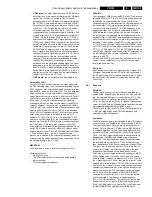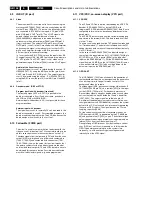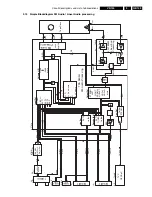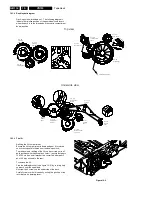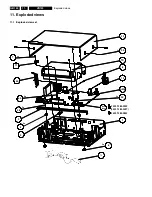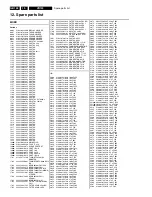
Tape deck
GB 117
VR120
10.
10.2 Adjustments
Adjustments must not be made in the service position.
10.2.1 Tape path
Figure 10-10
Roller left unit/roller unit right
Preparation:
Connect one input of a dual trace oscilloscope to observe the
tape sync pulse CTL. The other input (DC coupled) to
observe the tracking information TRIV.
Trigger the oscilloscope externally on the head pulse HP1
(“SWIN”).
Playback the black and white section of the alignment test
tape.
Set the deck in the condition where the video heads are
running along the upper edge of the tracks only by:
•
Call the service test program (see chapter 5.2 Service
test program).
•
Activate manual tracking (service test program step 03)
and watch the tape sync pulse move to the left in relation
to the TRIV signal.
•
Note the extreme left hand position reached by the sync
pulse, repeat as necessary.
•
Stop the movement of the pulse when the TRIV signal
reduces to 1/2 to 2/3 maximum amplitude by pressing the
normal play button. A noisy picture (disturbances) is
visible on the TV set and the CTL pulse should be to the
left of the display.
The recorder will hold this position until the service test
program step 03 is left.
This condition works only if X-distance is adjusted.
Figure 10-11
Adjustment:
Adjust the left and right roller units to make the tracking signal
TRIV straight and flat as possible ( see figure 10-11 ).
A/C Combi head
Tilt angle adjustment
Set the drive to feature mode (e.g. +7)
Adjustment :
By means of the tilt angle adjusting screw move the tape until
the lower edge just touches the tape guide A1 ( see figure 10-
12 ) the tape must not be distorted at the lower edge (by
pressing onto guide).
Figure 10-12
Adjustment of the azimuth angle and the head height:
Connect an oscilloscope to the linear Audio output.
Play the section of the test cassette with the audio signal 400
Hz.
Adjust for maximum output voltage by means of the height
adjustment screw
Play the section of the test cassette with the audio signal 8
kHz.
Adjust to maximum output voltage by means of the azimuth
adjustment screw ( see figure 10-12 ).
If necessary, repeat this procedure
Check the tilt angle adjustment
If the tape path was completely out of adjustment or if several
components in the tape path have been replaced, it is
possible, that the adjustments described in paragraph “Roller
left unit/roller unit right” and paragraph “A/C Combi head”
have to be repeated several times.
10.2.2 Adjustment of the horizontal distance (x-distance)
Before this adjustment is carried out, insert the test cassette
(start from Eject position). Call the service test program
(tracking value will take up its nominal position) and press the
„play“ button.
Playback the black/white part of the test cassette.)
Display the TRIV signal on an oscilloscope (DC-coupled) and
adjust for maximum voltage by means of the excentric screw
( see figure 10-12 ).
26
31
33/34
23
16
tilt screw
height screw
azimut screw
Tape guide
Capstan wheel
Tape guide
(Reverse lever)
Pressure roller
TAPE
Excenter for
X - distance
Summary of Contents for VR570
Page 12: ...Direction for use GB 12 VR120 3 3 Direction for use RT111 RT116 RT112 RT114 RT123 RT121 RT128 ...
Page 15: ...Direction for use GB 15 VR120 3 SAT VR870L VR870CC VR720 Set width 435 mm ...
Page 56: ...Service modes Repair tips GB 56 VR120 5 Engineer s remarks ...
Page 79: ...Circuit diagrams and PWB layouts Wiring diagram 79 VR120 7 7 16 Wiring Diagram Motherboard ...
Page 81: ...Circuit diagrams and PWB layouts Wiring diagram 81 VR120 7 Engineer s remarks ...
Page 82: ...82 VR120 7 Circuit diagrams and PWB layouts Wiring diagram Engineer s remarks ...
Page 83: ...Circuit diagrams and PWB layouts Wiring diagram 83 VR120 7 7 18 Mother board component side ...
Page 119: ...Tape deck GB 119 VR120 10 ...
Page 123: ...Tape deck GB 123 VR120 10 Engineer s remarks ...

